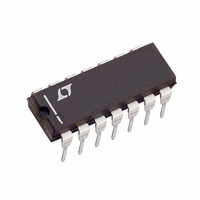LTC1148CN-5#PBF Linear Technology, LTC1148CN-5#PBF Datasheet - Page 12

LTC1148CN-5#PBF
Manufacturer Part Number
LTC1148CN-5#PBF
Description
IC SW REG STEP-DOWN 5V 14-DIP
Manufacturer
Linear Technology
Type
Step-Down (Buck)r
Datasheet
1.LTC1148CSPBF.pdf
(20 pages)
Specifications of LTC1148CN-5#PBF
Internal Switch(s)
No
Synchronous Rectifier
Yes
Number Of Outputs
1
Voltage - Output
5V
Current - Output
50mA
Frequency - Switching
250kHz
Voltage - Input
3.5 ~ 20 V
Operating Temperature
0°C ~ 70°C
Mounting Type
Through Hole
Package / Case
14-DIP (0.300", 7.62mm)
Lead Free Status / RoHS Status
Lead free / RoHS Compliant
Power - Output
-
Available stocks
Company
Part Number
Manufacturer
Quantity
Price
APPLICATIO S I FOR ATIO
LTC1148
LTC1148-3.3/LTC1148-5
2. MOSFET gate charge current results from switching the
3. I
12
LTC1148 DC supply current is 160µA for no load, and
increases proportionally with load up to a constant
1.6mA after the LTC1148 series has entered continu-
ous mode. Because the DC bias current is drawn from
V
V
for load currents over 30mA. However, at very low load
currents the DC bias current accounts for nearly all of
the loss.
gate capacitance of the power MOSFETs. Each time a
MOSFET gate is switched from low to high to low again,
a packet of charge dQ moves from V
resulting dQ/dt is a current out of V
much larger than the DC supply current. In continuous
mode, I
for a 0.1Ω N-channel power MOSFET is 25nC, and for
a P-channel about twice that value. This results in
I
a 2% to 3% typical mid-current loss with V
Note that the gate charge loss increases directly with
both input voltage and operating frequency. This is the
principal reason why the highest efficiency circuits
operate at moderate frequencies. Furthermore, it ar-
gues against using larger MOSFETs than necessary to
control I
well as money!
of the MOSFET, inductor, and current shunt. In continu-
ous mode the average output current flows through L
and R
and N-channel MOSFETs. If the two MOSFETs have
approximately the same R
one MOSFET can simply be summed with the resis-
tances of L and R
example, if each R
R
results in losses ranging from 3% to 12% as the output
current increases from 0.5A to 2A. I
efficiency to roll-off at high output currents.
Figure 5 shows how the efficiency losses in a typical
LTC1148 series regulator end up being apportioned.
GATECHG
2
IN
IN
SENSE
R losses are easily predicted from the DC resistances
, the resulting loss increases with input voltage. For
= 10V the DC bias losses are generally less than 1%
SENSE
GATECHG
= 0.05Ω, then the total resistance is 0.3Ω. This
2
= 7.5mA in 100kHz continuous operation, for
R losses, since overkill can cost efficiency as
, but is “chopped” between the P-channel
= f (Q
U U
DS(ON)
SENSE
N
+ Q
DS(ON)
to obtain I
= 0.1Ω, R
P
). The typical gate charge
, then the resistance of
W
IN
2
R losses cause the
IN
which is typically
L
2
to ground. The
R losses. For
= 0.15Ω, and
IN
U
= 10V.
Other losses including C
losses, MOSFET switching losses, Schottky conduction
losses during dead time, and inductor core losses, gener-
ally account for less than 2% total additional loss.
Design Example
As a design example, assume V
V
can immediately be calculated:
Assume that the MOSFET dissipations are to be limited to
P
If T
is 50°C/ W, then the junction temperatures will be 63°C
OUT
N
The gate charge loss is responsible for the majority of
the efficiency lost in the mid-current region. If Burst
Mode operation was not employed at low currents, the
gate charge loss alone would cause efficiency to drop to
unacceptable levels. With Burst Mode operation, the
DC supply current represents the lone (and unavoid-
able) loss component which continues to become a
higher percentage as output current is reduced. As
expected, the I
R
t
C
L
OFF
= P
A
MIN
T
SENSE
= 50°C and the thermal resistance of each MOSFET
= 5V, I
= 2.92µs/[(1.3)(10
P
= (1/200kHz)[1 – (5/12)] = 2.92µs
= 5.1(10
= 250mW.
100
= 100mV/2 = 0.05Ω
90
85
80
95
0.01
MAX
LTC1148 I
5
2
= 2A, and f = 200kHz; R
GATE CHARGE
Figure 5. Efficiency Loss
)0.05Ω(220pF)5V = 28µH
0.03
R losses dominate at high load currents.
OUTPUT CURRENT (A)
Q
0.1
4
)] = 220pF
IN
and C
0.3
IN
OUT
1
LTC1148 • F05
= 12V (nominal),
I
2
ESR dissipative
R
SENSE
3
, C
T
and L
114835fd














